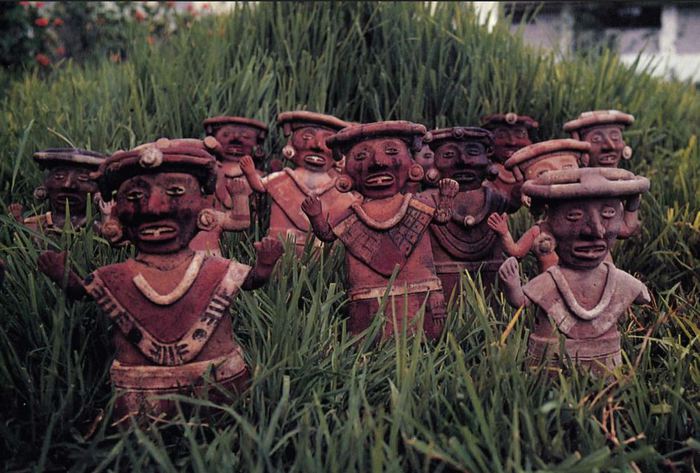The female cult in Xochitécatl
One of the main indicators of the female cult in Xochitécatl is the multiple offerings of female figurines found at the site.

The Xochitécatl-Nativitas-Nopalucan block is a geological formation located in the valley of Puebla-Tlaxcala, where the archaeological zone known as Cacaxtla-Xochitécatl is also found. This block is notable for the mural paintings located in the site of Cacaxtla that portray ritual scenes and the cosmogony of the ancient inhabitants.
Less than 2 km away from Cacaxtla is Xochitécatl, a site located on what used to be a volcano and was used as a civic-ceremonial center that was built in 800 B.C. This first occupation took place with the construction of three of the four buildings that currently make up the settlement, while housing units were built around the ceremonial center.
The ceremonial center of Xochitécatl consists of a large two-level plaza on which four buildings were built:
1) The Serpent Building, consisting of a quadrangular floor plan with uncoated white slab walls;
2) The Circular Building, built with a circular floor plan and stepped bodies;
3) The Pyramid of Flowers, consisting of sloped bodies that support the facade and a temple;
4) The Basement of the Volcanoes, built between 650 and 950 A.D, after the site had been abandoned for 400 years due to the collapse of the food production system as a result of natural disasters.
Cacaxtla-Xochitécatl played an important role in the administration and control of this region of the Puebla-Tlaxcala valley, as it controlled the entry and exit of products from the Gulf Coast and Oaxaca.
In the Pyramid of the Flowers, a structure that is made up of eight bodies placed in a staggered manner and that presents two constructive moments, some anthropomorphic sculptures and burials of bodies that correspond to the second occupation of the site were found. These discoveries, distinctive of this site, have allowed the study of hypotheses that indicate that Xochitécatl could have been a ceremonial center dedicated to the cult of female deities.
One of the main indicators of the female cult in Xochitécatl is the multiple offerings of female figurines found at the site. These figurines represent women with their arms raised in a position of prayer, pregnant women in whose belly a child figure is placed, richly dressed women, women carrying a child in their arms, children with face paint on their cribs, old women with smiles and painted bodies, warrior women and deified women.
According to researcher Mari Carmen Serra Puche of the UNAM's Institute of Anthropological Research, in the case of the figures of warrior or deified women, they are anthropomorphic representations sitting on a throne, carrying a shield and scepter and richly adorned. These figures represent a ruler, warrior, or priestess, but it is also believed that they may be deities or representations of elite characters.
Similarly, the richly decorated women's figurines feature red face paint, mutilated teeth, earmuffs, necklace, decorated skirts, and bare feet.
Some hypotheses suggest that the figurines could be representations of Xochiquetzal, Xilonen, and Tlazoltéotl; however, others indicate that they represent real women and not precisely deities.
"It is important to emphasize that the female figurines, which in large numbers are part of the offerings, represent birth, motherhood, maternal care, old age and death, that is, the cycle of women's lives, as well as the enthronement or possible social position as rulers or 'queens,'" says Serra Puche.
Other elements found at this site that have served as indicators of the feminine cult practiced here are the winches, the burial of young women and children, the staircase, the sculptures, and the water tanks.
The winches are objects linked to female deities and characters, as well as to fertility and water. These objects, mostly located in the upper part and on the staircase, show the importance given to weaving in pre-Hispanic times, an activity that was exclusive to women, revealing a difference in the value of women in Mesoamerica about Western society.
The sculptures found on the base of a man masturbating and a naked woman showing her sex with a hole in her belly are figures related to fertility; while the sculpture found of a woman with her jaws open and the body of a snake possibly represents Cihuacóatl, who in the Mexica cosmogony was considered the protector of women who died in childbirth.
Similarly, burials in the area reveal aspects related to female worship, as some are women's bodies. In several of these burials were found offerings of figurines, snails, beads, razors, vessels, and objects made of obsidian, greenstone, and bone, which indicates that they were burials that involved a complex ritual.
As far as the stairs are concerned, it has been found that most of the steps are made of reused metates. In this case, the metates are related to activities that in pre-Hispanic society were carried out exclusively by women, for which reason their presence as a constructive element has been considered to have a ritual meaning closely related to the cult of female deities. Likewise, the two water tanks at the site, where various anthropomorphic figures were also found, were spaces associated with baths or ritual deliveries.
"The most relevant conclusion we can draw so far about the findings of the Pyramid of Flowers in Xochitécatl, comes from the association and coincidence of archaeological evidence that indicates the constitution of female ceremonial space," says Mari Carmen Serra Puche.
She also adds: "Xochitécatl stretches like a bridge between the Great Mother Goddess of Teotihuacan and the multiple invocations of the divine feminine principle that appears in the Mexica era... the association of all these elements points towards ceremonies dedicated to Mother Earth, personified in the feminine volcano".
Source: Cultura




